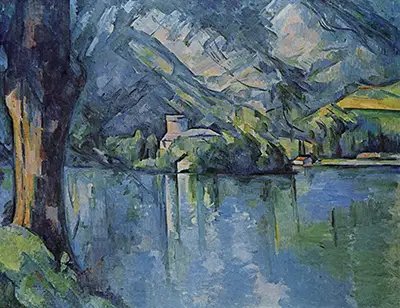Paul Cezanne's style changed over the years, from dark, brooding dramatically lit tableaux, in his twenties in which dreadful acts were played out (The Murder, The Rape and more), to lighter subjects like still-lifes and portraits of people he knew, as well as the landscapes that made him famous, such as this one: Lac D'Annecy, or Lake at Annecy, a small rural village in France, just an hour from the Swiss border, as evidenced by the immense mountains that loom over the image.
Cezanne disdained the scene, when he saw it, sneering that it was the type of picture postcard view that the Romantics or holiday-makers would treasure, rather than the carefully composed landscapes that invariably introduced an unusual point of view of the apparently mundane setting: an old building peeking over trees, a tall foregrounded tree dominating the distant view of an aqueduct. There are similar elements in this painting: the view point is of a lakeside house as seen from across the lake at a fair distance. The house is mostly hidden behind lush greenery, with only its roof and chimney clearly visible, as well as smaller outhouses or cottages, a little distance away. However, what seems to have driven Cezanne's motivation when it comes to this scene is the geometry of the scene.
At this time in his career (and he had been painting with modest success for some 20 years, Cezanne had long been under the influence of Pissarro – who he called 'the father' – who had led Cezanne into mixing his colours with a lighter touch) he had begun to break art down into shapes, uttering the well-known phrase that he wanted to 'treat nature by the cylinder, the sphere, the cone'. This interest can be seen in the painting, which is divided by strong diagonals, creating diamond shapes, triangles and a cross that runs from top left to bottom right and top right to bottom left. All these shapes are subtle, following the lines of the mountains in the background, counterpointed by the branches of the tress, a curved cylinder that forms a half-frame for the lakeside scene.
The effect of these layers of geometric shapes, taken with the somewhat brooding colours used: deep blues and greens, atmospheric purple and brown, enlivened with touches of palest pink, white, and yellow, give the image, which should be superficially pretty, like a Romantic ode to nature, an intensity and impact that make the deceptively simple image a striking one that lingers long after viewing. The relatively small oil painting, a mere 65 by 81 centimetres, hangs in the Courtauld Gallery in London.




